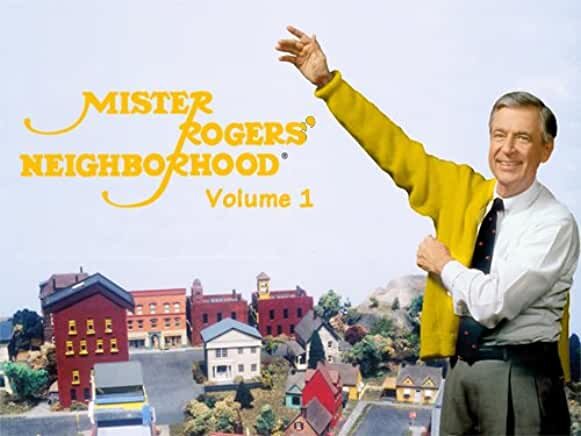The Importance of Mister Rogers Changing His Shoes
I grew up watching Mister Rogers’ Neighborhood on public television. My mother would say that I found it calming, reassuring even, although I maintain that I learned a great many lessons about life in the world from Mister Rogers. I recently watched the film A Beautiful Day in the Neighborhood starring Tom Hanks, and so Mister Rogers has been on my mind recently.
At the beginning of every episode of Mister Rogers’ Neighborhood, Mister Rogers would enter his television home wearing a jacket and tie, as if he was coming home from work at an office job, exchange his relatively bland work jacket for a more colorful cardigan, and exchange his dress shoes for more casual Sperry Top-Siders or Converse sneakers, all while singing his now-famous song, Won’t You Be My Neighbor?
While it was undoubtedly charming of Mister Rogers to go through this routine, episode after episode, year after year, itself becoming a kind of signature that made it easy for Tom Hanks to channel Mister Rogers simply by going through the same routine, what was the actual purpose of Mister Rogers’ changing his shoes when entering his television home, and exchanging his jacket for a more comfortable, colorful cardigan? What message was Mister Rogers trying to convey to children and parents by modeling this behavior on television for years on end?
The simple answer is routine. Just as the set of Mister Rogers’ Neighborhood underwent very few changes over the years that the show was on television, the routine of singing Won’t You Be My Neighbor? with a smile and while changing into his television at-home clothes provided a kind of stability for the television world, or rather the television home and neighborhood, into which children were entering. Children grow and learn best when they have some baseline stability to their lives, which Mister Rogers was trying to provide on television to children viewers who may not have had much—or as much—stability in their actual home lives.
But I believe the lesson in Mister Rogers’ donning of his casual shoes and cardigan goes much deeper than mere routine and stability. In this increasingly busy modern/contemporary world we inhabit, it’s very easy for parents to be so preoccupied by their own work or professional lives that they never really leave work at the door—that they are never really or fully present even at home, much less willing to immerse themselves in the reality of their children's lives and worlds, to meet children at their own level while maintaining their stability and presence as adults for their children, a balance which Mister Rogers struck quite naturally and seemingly effortlessly on television.
To me, Mister Rogers’ routine of changing into his casual shoes and cardigan was a complex message about all of the following:
Leave work at work and be fully present when you get home.
The world of work, however important, is subordinate to home life, which should have priority.
Remain an adult and a stabilizing parental figure, but be willing to enter the world of your children and fully engage with them at their own level.
Provide a stable environment with enough routine and reliability for your children to grow and flourish in ways that are unique to them.
Even the colors of Mister Rogers’ television work clothes versus those of his outfits for his television home life are significant. The work clothes are fairly neutral—greys and browns and dark blues—while his cardigans are sometimes (but not always) brighter, more colorful, and more comfortable, and his shoes obviously more casual compared to his work shoes despite themselves often being a relatively dark shade of blue. While the color schemes and contrasts of Mister Rogers’ outfits are meant to reinforce the principle that home life is generally more vibrant and more important than work life, deserving of one’s full attention and presence, it perhaps also says something about corporate work culture in the late 20th century with its impersonal offices, cubicles, and hierarchies—and with the corresponding nihilism of slaving away at a job that is less authentic than one’s own home life is, or should be.
What would Mister Rogers’ Neighborhood be like in the 21st century world of working from home or in jobs that are (at least in some cases) more authentic? A more authentic job is much harder to leave at the door when you get home than an inauthentic one, and a work-from-home job is impossible to leave at the door by definition. How, then, do we revive and sustain Mister Rogers’ principles of being fully present at home for the sake of our families and children, and leaving our work context at the end of the day—in a sense that the philosopher Wittgenstein would have appreciated, given his emphasis on contexts and the differences language games that we weave in and out of in the course of our days and lives—for the sake of fully entering our home lives and of engaging with our children within their own worlds and contexts even as adults and parents?
Mister Rogers, with a song and a smile and a change of outfits, established a firm boundary on television between work life and home life, with an emphasis on the latter. And this boundary between work life and home life can be constructed even within a work-from-home situation using some of Mister Rogers’ own techniques:
Even if you work from home, get dressed for work and then change into more home-appropriate clothes when your work day ends.
Begin and end your work-from-home day at predictable, regular times.
When you sign off from work, be fully present at home, not letting work linger, and avoiding letting your attention drift back to electronic devices.
Make family in general, and children in particular, the priority when the work day ends, with the aim of demonstrating children’s own inherent value to themselves and with the aim of demonstrating that you like/love your children exactly as they are—and that you actually want to spend time with them.
So if you don’t currently make a strong distinction between your work life and home life, between your work clothes and your at-home clothes, take a play from Mister Rogers’ playbook and use his simple techniques to create balance in your life where you need it. Help yourself leave work at the literal or metaphorical door at the end of the day, to be fully present and engaged at home with your family, to provide yourself and your children with a degree of stability that is unquestionably beneficial to them from a developmental standpoint, and to ensure that your home life always takes priority over your work life—even when work gets stressful and no matter how seemingly important your job or career may be.









